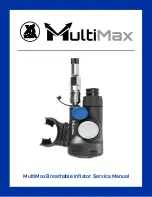
Finding faults with the
Electric Fence
FAULT FINDER
2. At each intersection
check readings in
each direction.
1. At the beginning of the fence.
A fault is indicated.
Arrow says ‘this way’
Voltage 1.5 kV is
lower
than usual
Current 9 amps is
higher
than usual
Types of faults
There are two common types of faults on electric fences:
1. An OPEN CIRCUIT is where the live wire is broken. In the sections of fence after the break there will
be NO voltage. These are relatively easy to find by testing the fence for voltage.
2. A SHORT CIRCUIT is where the live wire touches ground or an earth wire, or an insulator breaks
down. This leads to a reduced voltage throughout the system and no (or little) voltage at and beyond
the fault. When a SHORT circuit occurs a large amount of current flows through the live wires.
Checking your fence
VOLTAGE: Use the FAULT FINDER to measure the voltage on the fence by placing the metal tip over the
live wire and pressing the
PRESS
button. The reading is shown by the 2 digits on the left side of the
display. If it is
lower
than usual then you may have a short circuit. To be an effective barrier the fence
should read higher than 2.5 kV. For
Bi-Polar
Energiser users: A “+” sign in the middle of the LCD shows
that the voltage polarity of the wire is positive. This is helpful in determining which of the two live wires
you are testing in a Bi-Polar system.
CURRENT: The FAULT FINDER will also be measuring current flow in the fence when the
PRESS
button is
pressed. Current flow is shown on the right side of the display. A
higher
than usual reading indicates
that you may have a short circuit.
Take the time to "play" with the FAULT FINDER. Place pretend "faults" (short the live wire to
3.
Keep following the direction
arrow to the fault.
Arrow says ‘this way’
grounded metal) on your fence and “find” them. The experience will be invaluable when you
come to find “real” faults. Get to know the "usual" current used by your fence and the "usual"
voltages around the system. As a guide, usual current will be approximately 1 amp for every 4
kilometers of live wire. This will also depend on seasonal conditions such as grass and moisture.
Fault Finding Technique
Always start close to the energiser
- (But not within 30cm). Where the lead out wire connects
to the fence is a good place to start. This way you will always start on the energiser side of a
fault.
1. Place the metal tip over the lead out wire and press the
PRESS
button. If the voltage is
lower
than usual and the current is
higher
than usual you may have a short circuit. (see
‘Checking your fence’) The fault direction arrows will light when the Fault Finder calcu-
lates that the leakage (current) is worse (
higher
) than an acceptable value.
2. Follow the direction arrows towards the fault. Check the fence at regular intervals and at
every side fence or intersection, also each side of joins and underground cables.
3.
If the Fault Finder shows faults in more than one fence line or wire ALWAYS follow the
direction with the worst (
highest
) current reading.
Note: for a multiwire fence the current flow will be seen on the “feed” wire but not on the
“blind” (dead-end) wires.
No
current and
no
arrows means
not
‘this way’




















